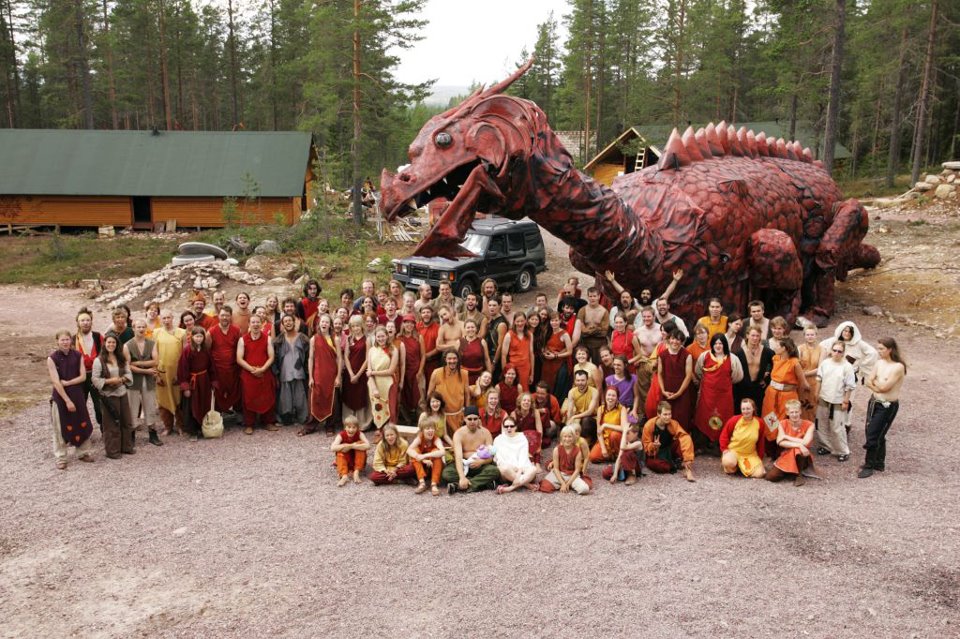This is the fourth part of a series on Opt-In, Opt-Out Design. These posts are intended to establish a bunch of concepts and basics before going into nitty gritty (case studies and so on). The first part was an introductory video. The second instalment was a text about why the opt-in, opt-out design philosophy is a good practical baseline, especially if your players have limited larp experience. The third discussed things your players will need to know at signup.
This fourth piece is about a very specific sub-issue, namely people who opt into your larp, engage with your materials, sign up, prepare and get all the way to the location – and then get very angry at something, scream at you, and leave.
Leaving the larp is of course also an entirely normal way of opting out, and I personally think we should always design for that to be possible, for all kinds of reasons. This blog post is not about that. It is not about a player, upon consideration, deciding to leave the larp because they realise that they cannot, for some personal reason, continue playing.
This blog post is about rage quitting. Or really mostly about rage. About on-site participant rage and its causes. Sometimes you manage to resolve the rage issue so that people stay and play anyway. They might even have a great larp. Sometimes you don’t, and then they quit on you.
I have been at the receiving end of participant rage. I have also been the person feeling the rage. I haven’t rage quit, but I think if I’d have had a driver’s license and access to a car, I probably would have at least once.
I think most of the language below is also applicable to the freaked-out or deeply disappointed player who has enough self control not to explode in your face (or who trusts you so little that they don’t even want to talk to you). They’re basically just saving their rage for later, but that has the benefit that you may be able to pre-empt it.
Rage Quitting In Larp

The term rage quitting is adopted from video gaming, where it often means aborting a play session either because you’re losing, as a reaction for trolling from other players, or because you’re enraged with the bugginess or difficulty of the system.
In collaborative-style larps, though, “winning” and “losing” are not meaningful concepts, and “trolling” is a marginal phenomenon (at least in the play cultures I’ve been directly exposed to). When players rage-quit larps, then, the reasons veer towards the last two kinds of thing: their experience being “buggy” – for instance because of logistical breakdowns – or the larp itself being unplayable for them in some way.
From the organiser/designer perspective, an angry, super-sad, freaked-out or massively offended player is both a terrible burden on resources (such as time, attention, and energy) and super annoying (because one either feels their complaint is unfair, or that their complaining is distracting from solving a real problem).
From the player perspective, of course, the problems are always real, and the emotions are definitely real, and they are often accelerated by a feeling of betrayal, which means you can’t actually ask the enraged player to shut up or wait, because that would make them feel even more abandoned.
If you are an experienced organiser, you probably have one person on location to deal with this kind of thing. You might be able to validate the player’s experience and their feelings, acknowledge your responsibility and apologise as appropriate, and find a workable solution that allows them to play. But would it not be nicer if you didn’t have to deal with it at all?
Please note: this blog post is not about larp criticism in general, or players having questions and uncertainties on site, or seeking attention, or about people having political objections to your larp before it’s even announced, or about design criticism delivered after the larp in ways that undermine the experience of players who were actually happy with it. Those are important issues and absolutely worth discussing.
This post is exclusively about the problem that the super enraged participant represents to the larpmaker on site, when the larpmaker is typically too tired or busy to deal with it in a good way, which then affects the other players negatively, and may have a long afterlife on the internet after the fact.
In an earlier post, I wrote:
The majority of your problems with sad, freaked-out or offended players can be resolved by being really good at communicating what it is you’re offering. When people are already signed up (or even worse: are already on location) it is far too late to reveal information that could change their mind about whether they want to play. They might then feel you have broken an implicit contract, and for instance demand changes in your work, or just drop out really inconveniently at the last moment.[A.k.a. rage quit]
Not Your Fault But Still Your Problem?
Make no mistake: there are absolutely people who just bring their own drama, and if you organise events or communities long enough you will eventually meet one. Some of them have mental health issues, some are just difficult or selfish, and dealing with them in constructive ways is its own kettle of fish. (Over at her blog, Lizzie Stark is encouraging us all to figure out whether perhaps we ourselves are creating drama where none is needed).
There are also people who just misunderstand or miss something that has actually been communicated. A good friend of mine signed up to a larp with a fair amount of sexual content without actually reading the game description, because she had liked the designer’s previous work. She was slightly outraged and quite disappointed, as she did not feel like playing on sexual themes – but I think even she agreed in the end that this was basically her own fault. However…
…Her unhappiness and inability to engage with play are of course still the organisers’ problem, and it would have made sense to communicate the content much clearer and, (like some larpmakers making intense games already do) to also require her as part of the signup to specify that she had understood the game’s content. This is good practice, but since players get disappointed, confused or angry about a whole range of different things, and you can’t have them sign off on everything, this is not foolproof either.
Also, if you organise a recurring thing, your more experienced participants will increasingly assume they already know everything, and stop reading or listening to important information.
Disappointment is Relative to Expectation

Here’s the thing though: most of the players screaming or crying or demanding things of you are probably reasonably socially competent, reasonably “sane”, and reasonably well-informed. They feel you’ve let them down (and clearly you have, since that can only be measured relative to expectation).
I cannot emphasise this enough: disappointment is relative to expectation. The seed to your players’ disappointment is planted before they even arrive on location, through the expectations you create in them, implicitly or explicitly.
As a larpmaker, therefore, you may seem to have two apparently conflicting goals: attracting participants to your event, and giving them realistic expectations.
I call the goals “apparently conflicting”, because that is actually phrased wrong. If you’ve ever had a player yell at you, or ruin the experience for everyone else by refusing to engage with the intended design, you’ll know that the goal shouldn’t be “attracting participants”, but “attracting the right participants” – those who are willing and able to play your larp together.
To play the larp you will actually be running.
If you value inclusiveness highly, or need to maximise the number of tickets sold for financial reasons, you will be tempted to try to make your larp suitable for everybody. This is not a trivial task, and if you make that promise, you better live up to it too.
Hype vs Expectation Management
You may be tempted to create hype around your game for marketing purposes. One dictionary definition of hype is “deception for the sake of marketing”. If you obfuscate details about the experience (explicit deception), or for instance create a very professional-looking web-site even though your logistics team consists of four chimpanzees managed by a child (implicit deception) you should not be surprised or offended by players raging at you – or quitting on you.
The players who opt into your larp are choosing the experience you have communicated. Not the compromise you’ll end up with after having run out of time and other production resources (as you inevitably will). Not even the larp that is in your mind. They expect the larp that is in their mind, because you put it there.
If you do not communicate to your participants what the larp’s basic outline and organisational principles are, they will inevitably fill in the gaps with their assumptions or guesses, but still hold you accountable for not living up to their imagined larp.
As I started writing about rage quitting, I realised I didn’t actually have a specified list of the kinds of things participants generally need to know at signup. So I wrote one; it is Basics pt 3 and you can find it here. It is a good place to start.
Unfortunately, you are not the only communicator of your larp. The image of your production is shaped by all the conversations about it everywhere in the physical and digital worlds. Hype, fantasies, and misunderstandings might attach themselves to your larp regardless of how clear and realistic your own descriptions are. This can happen for instance because your game concept or location are just super awesome, because some tastemakers in your community have signed up, or because of some throwaway comment you made months before the game wasn’t even announced yet.
If you are working with hype, or hype attaches itself to your larp, having a person on your team handling social media responses and enquiries is smart. Keeping track of what images of larp the potential and signed up player base have developed between them is a time-consuming task. As will become clear below, however, this is an investment that will likely pay itself back down the line.
Ownership or Entitlement?
When we’re at the receiving end of participant rage, we often view it as a kind of “consumerist” reflex. We feel participants are treating the larp as a product and us larpmakers like evil corporations, and that feels bad, since we’re actually well-meaning artists, whether or not we charge for or make money on the events we create.
It would be constructive here to be able to think two thoughts at the same time. One is that whether we like it or not, the larp is a product. We have made some promises, and often received money, which in many places even makes the promises we have made legally binding.
The second thought is that at the very least the player has invested attention and time, and they have done it with the intention of participating in – in other words: contributing to – our larp. Inviting people to participate in a larp is a big ask. You are inviting grownups to play; you are inviting them to engage their emotions and their bodies and to create something together with you. By the time they show up on location you may also have lured, inspired, or instructed them to prepare, study and create something in preparation, and/or to invest money in not only the ticket, but also their travel, equipment and freeing time.
In exchange, you give your participants some influence over the outcome, and responsibilities. You give them some ownership. And the attitude that may feel a lot like entitlement when their rage spit is hitting you in the eye is quite often a feeling of betrayal.
They may feel the tradeoff is unbalanced – that they are asked too much and given too little. They may feel their investment, their ownership, gives them the right to be heard, or even a right to make decisions about how you allocate your resources, or to control how other players engage with the larp.
They don’t have a right to decide stuff about your larp unless you’ve specifically told them they do. But they have some rights, like the right to demand you live up to your promises and, yes, the right to be heard.
Rage is not constructive. But at the point when a participant is feeling rage, some important personal limits have clearly been crossed. Rage is a defence mechanism. Rage quitting combines the two most fundamental defences we have! Fight. Flight.
Typical Reasons for Rage

Typical reasons for rage quitting can be organised in four broad categories:
- Cultural Assumptions & Misunderstandings. Your players think what you told them means something else. There are differing expectations about what constitutes acceptable humor, touching, content.
- Perceived or actual threats to physical or emotional safety. Something horrible happens that you could have prevented. Maybe you forget to tell players about the ravine in the dark forest. Maybe you design a fictional culture that will fatshame your players.
- Non-delivery of core infrastructure. You promise a camp, or food, and do not provide them.
- Non-delivery of core game content. You accidentally cast two players as the exact same character. Or you make many plots dependant on a magic object you then forget to introduce in the game. You promise aesthetics you can’t deliver.
Feeling safe, seen and recognised – valued – are fundamental human needs. You’ll usually find a lack of one or more of these at the base of participant rage. Try to figure out as fast as you can which are involved, so you don’t accidentally escalate the situation by depriving your participant even further of that specific thing. If they don’t feel safe, make an extra effort to be non-threatening. If they feel ignored, give them extra attention. And of course: listen, validate, evaluate, act – and apologise if needed, as part of validation.
In a co-creative environment, I think being recognised and valued are extra important for feeling safe to play. Don’t diminish the value of your participant’s contribution to your project. Even when their reaction is actively depriving the project of an even more valuable resource – your attention.
Letting Them Stay, Letting Them Go
I started out writing this piece like I always do, with my sympathies with the organiser. But then I gathered a bunch of stories about actual rage quitting and to be honest, quite often the organiser is at fault. This sucks because everything becomes about communication and prevention.
When it is too late for those things (and you will find that out only when it is) the best strategy is to face the music. Listen, admit fault if you are at fault, ask what a good outcome would be for the angry person, ask for help, ask for time – this will also give them time to calm down. Give them some choices, any choices.
Say, “I’m really sorry. I messed up, and you are right. At this time the other players need my attention. If you feel like you need to leave, I understand, and I’d be happy to give you your money back. If you’d be willing to wait around for a while, I’ll be back in an hour and then we can talk some more. Maybe you can think about what you’d need to be able to continue playing.”
“There is tea in the office. Help yourself to the biscuits. If you don’t feel like playing anymore, I understand, but maybe you’d be interested in taking on another role – perhaps helping us run the larp? Think about it. I will talk to you in a little while. If you feel you need to leave before I get back, please leave a note so I know you’re not lost in the forest.”
If their grievance cannot be resolved, and there is literally no one at hand to listen to them, let them go.
“I’m really sorry we let you down. I hear you. I understand that you want to leave. I really wish I had time to talk to you, but as you understand, we’ll need to run twice as fast to keep the larp going. I’d be happy to talk to you on Monday – would you prefer facebook chat or a phone call? Do you need help with your travel? The bus schedule is on the desk. Or feel free to use the phone to call your ride. Of course we’d rather see you stay and play.”
Or, the hardest one.
“I hear that you’re upset. I realise now that we could have been much clearer. When you’re screaming at me I find it very difficult to process what you’re saying. I’m sorry you had a terrible experience, but since you feel this strongly about it and the problem cannot be resolved, I think you are right: you should probably leave. I’d be happy to talk to you some more when we’re both less upset.”
